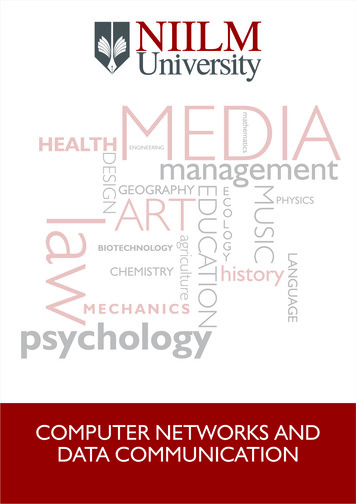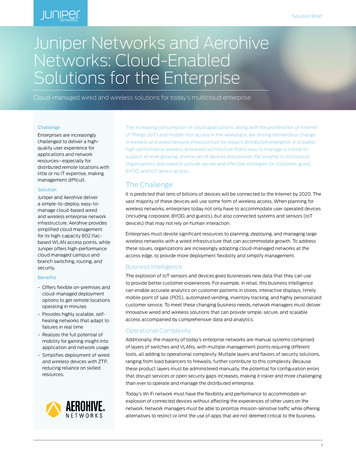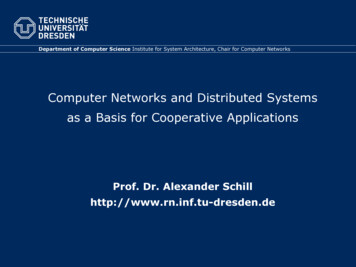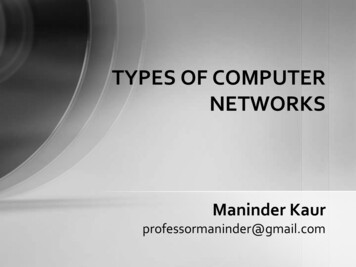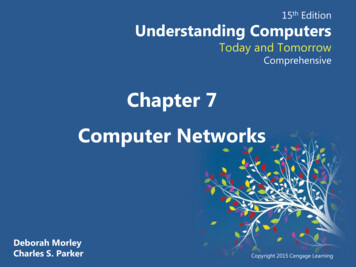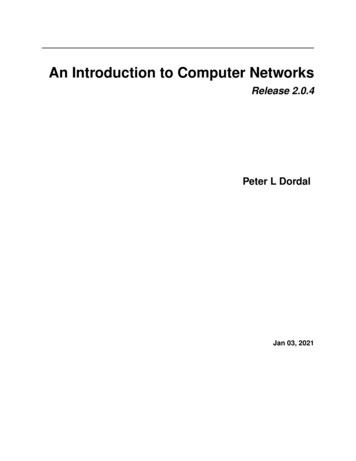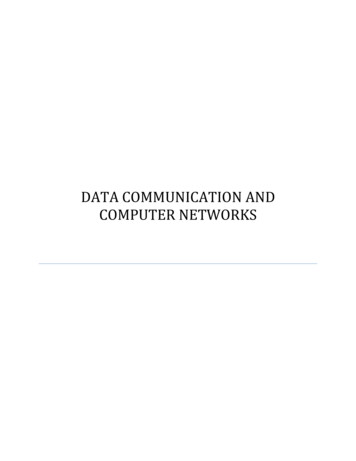
Transcription
DATA COMMUNICATION ANDCOMPUTER NETWORKS
DATA COMMUNICATIONSData communications are the exchange of data between two devices via some form oftransmission medium such as a wire cable. For data communications to occur, thecommunicating devices must be part of a communication system made up of a combination ofhardware (physical equipment) and software (programs). The effectiveness of a datacommunications system depends on four fundamental characteristics: delivery, accuracy,timeliness, and jitter.1. Delivery. The system must deliver data to the correct destination. Data must be received bythe intended device or user and only by that device or user.2. Accuracy. The system must deliver the data accurately. Data that have been altered intransmission and left uncorrected are unusable.3. Timeliness. The system must deliver data in a timely manner. Data delivered late are useless.In the case of video and audio, timely delivery means delivering data as they are produced, in thesame order that they are produced, and without significant delay. This kind of delivery is calledreal-time transmission.4. Jitter. Jitter refers to the variation in the packet arrival time. It is the uneven delay in thedelivery of audio or video packets.Components:A data communications system has five components.Data Communication and Computer NetworksPage 2
1. Message. The message is the information (data) to be communicated. Popular forms ofinformation include text, numbers, pictures, audio, and video.2. Sender. The sender is the device that sends the data message. It can be a computer,workstation, telephone handset, video camera, and so on.3. Receiver. The receiver is the device that receives the message. It can be a computer,workstation, telephone handset, television, and so on.4. Transmission medium. The transmission medium is the physical path by which a messagetravels from sender to receiver. Some examples of transmission media include twisted-pair wire,coaxial cable, fiber-optic cable, and radio waves5. Protocol. A protocol is a set of rules that govern data communications. It represents anagreement between the communicating devices.DATA TRANSMISSION MODESCommunication between two devices can be simplex, half-duplex, or full-duplex.Simplex:In simplex mode, the communication is unidirectional, as on a one-way street. Only one of thetwo devices on a link can transmit; the other can only receive. Keyboards and traditionalmonitors are examples of simplex devices. The keyboard can only introduce input; the monitorcan only accept output. The simplex mode can use the entire capacity of the channel to send datain one direction.Half-Duplex:In half-duplex mode, each station can both transmit and receive, but not at the same time. Whenone device is sending, the other can only receive, and vice versa. In a half-duplex transmission,the entire capacity of a channel is taken over by whichever of the two devices is transmitting atthe time. Walkie-talkies and CB (citizens band) radios are both half-duplex systems. The halfduplex mode is used in cases where there is no need for communication in both directions at thesame time; the entire capacity of the channel can be utilized for each direction.Data Communication and Computer NetworksPage 3
Full-Duplex:In full-duplex both stations can transmit and receive simultaneously. The full-duplex mode islike a two way street with traffic flowing in both directions at the same time. In full-duplexmode, signals going in one direction share the capacity of the link: with signals going in the otherdirection. One common example of full-duplex communication is the telephone network. Whentwo people are communicating by a telephone line, both can talk and listen at the same time. Thefull-duplex mode is used when communication in both directions is required all the time. Thecapacity of the channel, however, must be divided between the two directions.Data Communication and Computer NetworksPage 4
NETWORKSA network is a set of devices (often referred to as nodes) connected by communication links. Anode can be a computer, printer, or any other device capable of sending and/or receiving datagenerated by other nodes on the network.Network CriteriaA network must be able to meet a certain number of criteria. The most important of these areperformance, reliability, and security.Performance:Performance can be measured in many ways, including transit time and response time. Transittime is the amount of time required for a message to travel from one device to another. Responsetime is the elapsed time between an inquiry and a response. The performance of a networkdepends on a number of factors, including the number of users, the type of transmission medium,the capabilities of the connected hardware, and the efficiency of the software.Reliability:Network reliability is measured by the frequency of failure, the time it takes a link to recoverfrom a failure, and the network's robustness in a catastrophe.Security:Network security issues include protecting data from unauthorized access, protecting data fromdamage and development, and implementing policies and procedures for recovery from breachesand data losses.PHYSICAL STRUCTURESTYPES OF CONNECTIONS: A network is two or more devices connected throughlinks. A link is a communications pathway that transfers data from one device to another. Thereare two possible types of connections: point-to-point and multipoint.Data Communication and Computer NetworksPage 5
Point-to-PointA point-to-point connection provides a dedicated link between two devices. The entire capacityof the link is reserved for transmission between those two devices. Most point-to-pointconnections use an actual length of wire or cable to connect the two ends, but other options, suchas microwave or satellite links, are also possible. When you change television channels byinfrared remote control, you are establishing a point-to-point connection between the remotecontrol and the television's control system.MultipointA multipoint (also called multidrop) connection is one in which more than two specific devicesshare a single link. In a multipoint environment, the capacity of the channel is shared, eitherspatially or temporally. If several devices can use the link simultaneously, it is a spatially sharedconnection. If users must take turns, it is a timeshared connection.Data Communication and Computer NetworksPage 6
PHYSICAL TOPOLOGY:The term physical topology refers to the way in which a network is laid out physically. One ormore devices connect to a link; two or more links form a topology. The topology of a network isthe geometric representation of the relationship of all the links and linking devices (usuallycalled nodes) to one another. There are four basic topologies possible: mesh, star, bus, and ring.1. Mesh: In a mesh topology, every device has a dedicated point-to-point link to every otherdevice. The term dedicated means that the link carries traffic only between the two devices itconnects. To find the number of physical links in a fully connected mesh network with n nodes,we first consider that each node must be connected to every other node. Node 1 must beconnected to n - I nodes, node 2 must be connected to n – 1 nodes, and finally node n must beconnected to n - 1 nodes. We need n(n - 1) physical links. However, if each physical link allowscommunication in both directions (duplex mode), we can divide the number of links by 2. Inother words, we can say that in a mesh topology, we need n(n -1) /2 duplex-mode links. Toaccommodate that many links, every device on the network must have n – 1 input/output ports tobe connected to the other n - 1 stations.Advantages:1. The use of dedicated links guarantees that each connection can carry its own data load, thuseliminating the traffic problems that can occur when links must be shared by multiple devices.2. A mesh topology is robust. If one link becomes unusable, it does not incapacitate the entiresystem.Data Communication and Computer NetworksPage 7
3. There is the advantage of privacy or security. When every message travels along a dedicatedline, only the intended recipient sees it. Physical boundaries prevent other users from gainingaccess to messages.4. Point-to-point links make fault identification and fault isolation easy. Traffic can be routed toavoid links with suspected problems. This facility enables the network manager to discover theprecise location of the fault and aids in finding its cause and solution.Disadvantages:1. Disadvantage of a mesh are related to the amount of cabling because every device must beconnected to every other device.2. Installation and reconnection are difficult.3. The sheer bulk of the wiring can be greater than the available space (in walls, ceilings, orfloors) can accommodate.4. The hardware required to connect each link (I/O ports and cable) can be prohibitivelyexpensive.Data Communication and Computer NetworksPage 8
2. Star Topology: In a star topology, each device has a dedicated point-to-point link only to acentral controller, usually called a hub. The devices are not directly linked to one another. Unlikea mesh topology, a star topology does not allow direct traffic between devices. The controlleracts as an exchange: If one device wants to send data to another, it sends the data to thecontroller, which then relays the data to the other connected device .Advantages:1. A star topology is less expensive than a mesh topology. In a star, each device needs only onelink and one I/O port to connect it to any number of others.2. Easy to install and reconfigure.3. Far less cabling needs to be housed, and additions, moves, and deletions involve only oneconnection: between that device and the hub.4. Other advantage include robustness. If one link fails, only that link is affected. All other linksremain active. This factor also lends itself to easy fault identification and fault isolation. As longas the hub is working, it can be used to monitor link problems and bypass defective links.Disadvantages:One big disadvantage of a star topology is the dependency of the whole topology on one single point,the hub. If the hub goes down, the whole system is dead. Although a star requires far less cable than amesh, each node must be linked to a central hub. For this reason, often more cabling is required in astar than in some other topologies (such as ring or bus).Data Communication and Computer NetworksPage 9
3. BUS: A bus topology is multipoint. One long cable acts as a backbone to link all the devicesin a network. Nodes are connected to the bus cable by drop lines and taps. A drop line is aconnection running between the device and the main cable. A tap is a connector that eithersplices into the main cable or punctures the sheathing of a cable to create a contact with themetallic core. As a signal travels along the backbone, some of its energy is transformed into heat.Therefore, it becomes weaker and weaker as it travels farther and farther. For this reason there isa limit on the number of taps a bus can support and on the distance between those taps.Advantages:Advantages of a bus topology include ease of installation. Backbone cable can be laid along themost efficient path, then connected to the nodes by drop lines of various lengths. In this way, abus uses less cabling than mesh or star topologies. In a star, for example, four network devices inthe same room require four lengths of cable reaching all the way to the hub. In a bus, thisredundancy is eliminated. Only the backbone cable stretches through the entire facility. Eachdrop line has to reach only as far as the nearest point on the backbone.Disadvantages:Disadvantages include difficult reconnection and fault isolation. A bus is usually designed to beoptimally efficient at installation. It can therefore be difficult to add new devices. Signalreflection at the taps can cause degradation in quality. This degradation can be controlled bylimiting the number and spacing of devices connected to a given length of cable. Adding newdevices may therefore require modification or replacement of the backbone. In addition, a faultor break in the bus cable stops all transmission, even between devices on the same side of theproblem. The damaged area reflects signals back in the direction of origin, creating noise in bothdirections.Data Communication and Computer NetworksPage 10
4. RING: In a ring topology, each device has a dedicated point-to-point connection with only thetwo devices on either side of it. A signal is passed along the ring in one direction, from device todevice, until it reaches its destination. Each device in the ring incorporates a repeater. When adevice receives a signal intended for another device, its repeater regenerates the bits and passesthem along.Advantages:A ring is relatively easy to install and reconfigure. Each device is linked to only its immediateneighbors (either physically or logically). To add or delete a device requires changing only twoconnections. The only constraints are media and traffic considerations (maximum ring length andnumber of devices). In addition, fault isolation is simplified. Generally in a ring, a signal iscirculating at all times. If one device does not receive a signal within a specified period, it canissue an alarm. The alarm alerts the network operator to the problem and its location.Disadvantages:Unidirectional traffic can be a disadvantage. In a simple ring, a break in the ring (such as adisabled station) can disable the entire network. This weakness can be solved by using a dualring or a switch capable of closing off the break. Ring topology was prevalent when IBMintroduced its local-area network Token Ring. Today, the need for higher-speed LANs has madethis topology less popular.Data Communication and Computer NetworksPage 11
NETWORK CATEGORIESLocal Area Networks (LAN):Local area networks, generally called LANs, are privately-owne
Data Communication and Computer Networks Page 2 DATA COMMUNICATIONS Data communications are the exchange of data between two devices via someform of transmission medium such as a wire cable. For data communications to occur,the communicating devices must be part of a communication system made up of a combinationof
